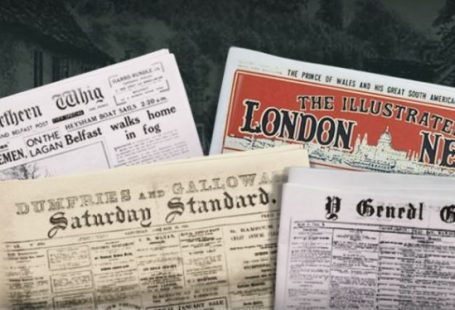This week has been another record-breaking week here at The Archive, as we have now reached another milestone of over 57 million pages all now available to search as part of our collection, with 633,752 brand new pages joining us in all over the past seven days. Meanwhile, we’ve added three brand new newspaper titles to the site this week, two of which illuminate the religious climate of the mid to late nineteenth century, whilst another shines a light on local news in Staffordshire.
This week has been an extraordinary one for our existing titles too, with significant updates joining some of our most important regional titles. So read on to discover more about all of our new and updated titles of the week, as well as to find out more about the wreck of the Annie Jane, an emigrant ship that sunk off the coast of the Scottish island of Vatersay in the September of 1853, with the loss of some 350 lives.
Register now and explore the Archive
The first of our two new religious-focused titles this week is the Church & State Gazette (London), which was first published on 18 February 1842. Although both Conservative and Anglican in its political and religious leanings, the Church & State Gazette was more moderate than its contemporaries the English Churchman and The Guardian, which were the leading High Church newspapers of the time.

Indeed, the first edition of the Church & State Gazette laid out its aims and intentions very clearly, stating how:
The title of our Gazette will explain its objects. In professing a desire to maintain the Union of Church and State, we exclude all principles and views hostile to the Established Institutions of the Empire. We have no sympathy either with the Adversaries of the Reformation, or with the Champions of the Reformation in opposition to Primitive Truth. We war against all doctrines, the tendencies whereof are on the one hand to Popery, and on the other hand to Dissent and Sectarianism…We support the State as the Nursing-Parent of the Church, and the Church as the Guide and Counsellor of the State.
The newspaper was unabashed as to regarding its politics, and the support that it hoped to derive from the upper classes, as well as from the emerging middle classes:
We rely for support not only upon the Nobility and Gentry, who from high birth and station may be considered hereditary patrons of Church and State principles, but also upon the thoughtful Middle Classes, who, in the gradual formation of right convictions, require both a guide and an interpreter. It is scarcely necessary to say, that in politics we are Conservative; as willing to improve, as unwilling to impair – reverencing the hoarded wisdom and rich experience of the Past, as the best guides in principle for the conduct of the details of the Present.

So what sort of content could you expect from the sixteen pages of the Church & State Gazette? Well, the newspaper included a variety of long-form articles, spanning several pages, which looked at such themes as the ‘Union of Church and State,’ examining the ‘theory and practice’ of such a union, as well as a look at religion in other countries, such as Prussia. Meanwhile, the Church & State Gazette contained extensive ‘Clerical Intelligence,’ which looked at the latest religious news from Oxford and Cambridge, as well as containing details of all the week’s ordinations, marriages and deaths amongst the clergy.
Appearing every Friday at the cost of five pence, the Church & State Gazette was edited by John Wilkes the younger in the 1840s, whilst John Doran (1807-1878), a writer who dealt with social items like manners, also worked at the newspaper. The Church & State Gazette went beyond its religious remit, furthermore, in publishing weekly ‘Parliamentary Analyses,’ as well as looking at international news and the latest from the worlds of ‘Court and Fashion.’ The newspaper ran for fourteen years, until 1856.
Picking up partly from where the Church & State Gazette left off was the Christian World, which was first published on 9 April 1857, a year after the former paper ceased publication. ‘Combining a companion for leisure hours, a Christian treasury, and readings for Sundays at home; with a record of passing events,’ the Christian World cost only one penny, and hoped to target a larger audience than that of the Church & State Gazette. Indeed, the Christian World dubbed itself as a ‘religious, literary, educational, philanthropic, commercial, agricultural and family journal and advertiser,’ and soon it was reaching a weekly circulation of 100,000 copies.

With the motto of – ‘In things essential, unity; in things doubtful, liberty; in all things, charity’ – which has been attributed to St. Augustine over the years, but was actually coined by German Lutheran Rupertus Meldenius, Christian World was Liberal in its politics, appearing every Friday.
Meanwhile, its first edition clearly laid out its aims, the newspaper aiming to be both an educational and family publication:
The cherished object of the editor and the writers in these columns will ever be to make the Christian World an independent, intelligent, and comprehensive newspaper for the people, as well as a rich repository of moral and religious truth, under a great variety of aspects. As a newspaper it will comprise, in a condensed and readable form, all the leading events of the time, in both Secular and Religious circles; and as designed for Family and Sunday reading, special care will be taken to furnish in every number an ample supply of articles that will interest all.
Furthermore, the Liberal newspaper would advocate ‘reform, retrenchment and peace,’ as well as acting as the ‘friend of progress.’ But what did the pages of the Christian World contain? As promised, the newspaper contained ‘secular news,’ featuring the latest ‘Foreign and Colonial’ updates from the likes of France, Portugal, China, Canada and Australia, as well as news from parliament and general news from across the United Kingdom.
But at the heart of this newspaper was its faith, of course, with a section entitled ‘Religious Department.’ This feature contained stories from the Bible, as well as a ‘Sunday School Treasury,’ and a look at ‘Religious Education in London.’ An important feature of Christian World was also its ‘Chronicle of the Churches’ section, which contained news from across the different Christian denominations, from Congregational to Baptist churches, from Wesleyan to Presbyterian churches, from Episcopal to Roman Catholic churches.

The newspaper, meanwhile, contained sermons, as well as advertisements relating to religious matters, for example for religious texts, or for open ministerial positions, as well as notices of births, marriages and deaths.
By the 1880s Christian World was known as the ‘largest penny religious paper,’ representing as it did ‘all the Evangelical denominations,’ as well as giving a ‘brief summary of secular, and a more detailed one of religious intelligence.’ It was claimed that the newspaper was read every week by nearly ‘half a million people,’ with an ‘incomparable literary staff’ offering ‘perfect editorial independence.’
Our final new title of the week is the Potteries Advertiser, which was founded as simply the Advertiser in Stoke-on-Trent, Staffordshire, in 1994. A companion newspaper to the Staffordshire Sentinel, to which we have added over 34,000 pages this week, the Potteries Advertiser was a weekly freesheet tabloid that was delivered to homes in the Potteries and northern Staffordshire, including the towns of Stoke-on-Trent, Hanley, Burslem, Tunstall, Longton, Fenton and Newcastle-under-Lyme.

Also known as the North Staffs Advertiser throughout its lifetime, the Potteries Advertiser appeared every Thursday, comprising of four different local editions. This newspaper ceased publication in May 2011, and was replaced by the single edition title the Sentinel Advertiser.
Meanwhile, we have updated 23 of our existing titles this week, with updates joining our newspapers from across England, Scotland and Wales. Our most remarkable update of the week is the over 228,000 brand new pages we have joining the wonderful Leicester Daily Mercury, which span over one hundred years, from 1880 to 1995. As previously mentioned, we’ve also updated the Staffordshire Sentinel this week, with over 34,000 new pages joining this title, from 1865 through to 1977. Another significant update this week are the over 23,000 new pages that have joined the Nottingham Evening Post, all from the year 1996.
We have also updated two of our Scottish titles this week, with new pages joining both the Scottish Leader and the Ayrshire Post. Wales isn’t left out either, with updates to the Pontypridd Observer over the last seven days.
The Sinking of the Annie Jane – September 1853
On 4 November 1853, our new newspaper the Church & State Gazette (London) reported how an ‘official inquiry’ was to be ‘instituted as to the loss of the Annie Jane, by wreck of which so many lives have been lost.’

The Annie Jane was an emigrant ship which had sunk on 28 September 1853, off the coast of Vatersay, an island in the Outer Hebrides, with the loss of some 350 lives.
The Dublin Evening Mail on 12 October 1853 tells the tragic tale of the Annie Jane’s final journey, which was ill-fated from the start. Bound to Quebec from Liverpool, with some 500 emigrants aboard, the Annie Jane returned to Liverpool after three weeks at sea, having suffered the loss of its ‘mizenmast and other spars.’ At this point, about ‘100 emigrants left the ship,’ but the Annie Jane was soon refitted, and she set out once more, on 9 September 1853.

But again the ship faced trouble at sea, on 15 September 1853 losing her mainmast, and by 23 September, she had lost all of her ‘upper spars, becoming quite unmanageable.’ By 28 September the Annie Jane, in the command of one Captain Mason, ‘came in sight of Barra lighthouse,’ in the Outer Hebrides.
The Dublin Evening Mail narrates the horror of what happened next:
They struggled hard to get to windward of the island, but, as the evening approached, it was clear the island could not be weathered. The ship’s head was therefore directed towards a flat sandy beach, and she struck about twelve o’clock at night with such fearful violence that all her framework started, shutting her cabin doors, so that the passengers in the cabin could not get out.

The article continues:
Another huge breaker struck on her quarter, and the poop sank, crushing some 200 emigrants to death. In ten minutes more the ship was in pieces. It was most heartrending to hear the shrieks of 300 human beings struggling for life. The poop deck by this time floated, and 100 of the emigrants and sailors found standing room on this fragment; many of them perished with cold, or were smothered under the trampling of others.
The graphic nature of this account is typical of the time, but unsettling for us to read today, as we can only imagine the horror felt by the passengers aboard the Annie Jane.
And by the time that day broke, when the tide ebbed, it was found that 348 people had ‘been drowned or killed in 15 minutes the previous night.’ The Dublin Evening Mail relates how the majority of the emigrants were Scottish, with a ‘good number’ being from Ireland, with others also being from Germany and France. Amongst the number were a ‘hundred house carpenters and joiners from Glasgow…fresh, able young men.’

This tragic loss of the Annie Jane put an end to 350 lives, who were hopeful of starting a new life in Canada, in the most violent and shocking way. You can read more from the Dublin Evening Mail about the sinking here, whilst this article from The Globe, 18 October 1853, contains further information about the wreck.
New Titles
Title | Years Added |
| Christian World | 1857-1890 |
| Church & State Gazette (London) | 1842-1856 |
| Potteries Advertiser | 1994 |
Updated Titles
This week we have updated 23 of our existing titles.
You can learn more about each of the titles we add to every week by clicking on their names. On each paper’s title page, you can read a FREE sample issue, learn more about our current holdings, and our plans for digitisation.
Title | Years Added |
| Accrington Observer and Times | 1994 |
| Ayrshire Post | 1994 |
| Chester Chronicle | 1999 |
| Clevedon Mercury | 1986 |
| Dorking and Leatherhead Advertiser | 1995 |
| Ealing & Southall Informer | 1995 |
| Leicester Daily Mercury | 1880, 1891, 1902, 1920, 1924, 1938, 1940, 1943, 1949, 1959, 1963-1966, 1973, 1975-1979, 1990-1992, 1994-1995 |
| Long Eaton Advertiser | 1949, 1953-1954 |
| Midweek Visiter (Southport) | 1994 |
| Nottingham Evening Post | 1996 |
| Peterborough Standard | 1989 |
| Pontypridd Observer | 1980 |
| Ripley Express | 1994 |
| Scottish Leader | 1887 |
| Scunthorpe Evening Telegraph | 1991, 1995, 1998 |
| Sevenoaks Chronicle and Kentish Advertiser | 1979-1985 |
| Staffordshire Sentinel | 1865-1866, 1871-1872, 1882, 1893-1896, 1902, 1966-1971, 1974, 1976-1977 |
| Staines Leader | 1995 |
| Surrey Mirror | 1986 |
| Sutton Coldfield News | 1995 |
| Taunton Courier, and Western Advertiser | 1885 |
| Torbay Express and South Devon Echo | 1995 |
| Uttoxeter Newsletter | 1995 |
You can keep up to date with all the latest additions by visiting the recently added page. You can even look ahead to see what we’re going to add tomorrow.





